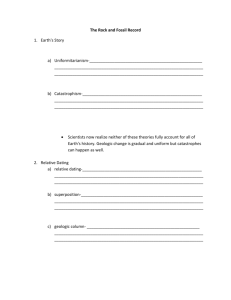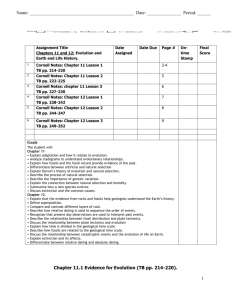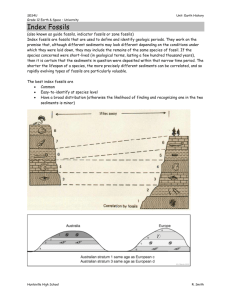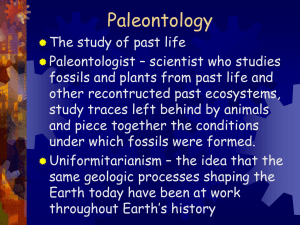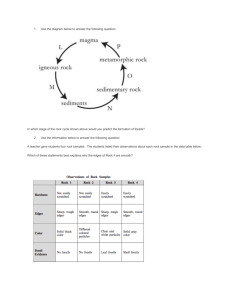Chapter 19 Biology Notes
advertisement
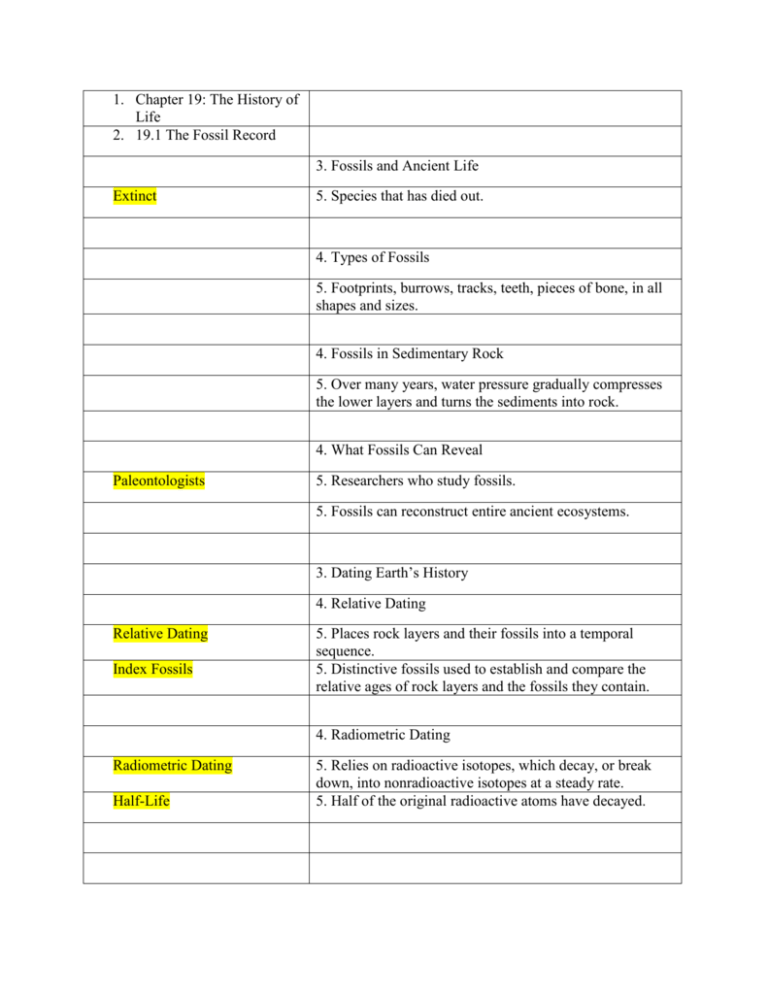
1. Chapter 19: The History of Life 2. 19.1 The Fossil Record 3. Fossils and Ancient Life Extinct 5. Species that has died out. 4. Types of Fossils 5. Footprints, burrows, tracks, teeth, pieces of bone, in all shapes and sizes. 4. Fossils in Sedimentary Rock 5. Over many years, water pressure gradually compresses the lower layers and turns the sediments into rock. 4. What Fossils Can Reveal Paleontologists 5. Researchers who study fossils. 5. Fossils can reconstruct entire ancient ecosystems. 3. Dating Earth’s History 4. Relative Dating Relative Dating Index Fossils 5. Places rock layers and their fossils into a temporal sequence. 5. Distinctive fossils used to establish and compare the relative ages of rock layers and the fossils they contain. 4. Radiometric Dating Radiometric Dating Half-Life 5. Relies on radioactive isotopes, which decay, or break down, into nonradioactive isotopes at a steady rate. 5. Half of the original radioactive atoms have decayed. 3. Geologic Time Scale Geologic Time Scale 5. Timeline of Earth’s history. 4. Establishing the Time Scale 5. Paleontologists discovered major changes in the fossil record at boundaries between certain rock layers. 4. Divisions of the Geologic Time Scale 5. Cretaceous Period was 80 million years long 5. Hadean Eon = 4.6 billion years ago 5. Archean Eon = 4 billion 5. Proterozoic Eon = 2.5 billion 5. Phanerozoic Eon from end of Proterozoic to present day 5. Eons are divided into eras. Era Period 5. A long and distinct period of history with a particular feature or characteristic. 5. A portion of time that ranges from nearly 100 millions of years to just under 2 million years. 4. Naming the Divisions 5. Precambrian time covers about 90 percent of Earth’s history. 3. Life on a Changing Planet 4. Physical Forces Plate Tectonics 5. Climate is one of the most important aspects of Earth’s physical environment. 5. Explains how solid “plates” move slowly above the Earth’s molten core- a process called continental drift. 5. Continental drift affects climate. 4. Biological Forces SUMMARY 5. Organisms today shape the landscape by building soil from rock, and sand and cycle nutrients through the biosphere. Paleontologists study the Earth, and they have a geologic time scale. Eons are separated into eras, and eras are separated into periods. 2. 19.2 Patterns and Processes of Evolution 3. Speciation and Extinction Macroevolutionary Patterns 5. Grand transformations in anatomy, phylogeny, ecology, and behavior 4. Macroevolution and Cladistics 5. Paleontologists study fossils to learn about patterns of macroevolution and the history of life. 4. Adaptation and Extinction 5. When a species fails to adapt to changing environments, they become extinct. 4. Patterns of Extinction Background Extinction 5. Standard rate of extinction ( slow and steady ) Mass Extinction 5. Many species over a relatively short period of time. 3. Rate of Evolution 4. Gradualism Gradualism 5. Involves a slow, steady change in a particular line of descent 4. Punctuated Equilibrium Punctuated Equilibrium 5. Equilibrium that is interrupted by brief periods of more rapid change. 4. Rapid Evolution After Equilibrium 5. When a small population can evolve faster than the larger population because of genetic changes spread more quickly among fewer individuals. 3. Adaptive Radiation and Convergent Evolution 4. Adaptive Radiation Adaptive Radiation 5. An evolutionary process by which a single species or a small group of species evolves over a relatively short time into several different forms that live in different ways. 4. Convergent Evolution Convergent Evolution 5. When evolution produces similar structures and characteristics in distantly – related organisms. 3. Coevolution Coevolution 5. The process by which two species evolve in response to changes in each other over time 4. Flowers and Pollinators 4. Plants and Herbivorous Insects. SUMMARY There are different rates, patterns, and types of evolution. 2. 19.3 Earth’s Early History 3. The Mysteries of Life’s Origins 4. The First Organic Molecules 5. In 1953, chemists Stanley Miller and Harold Urey tried recreating conditions on the early Earth to see if organic molecules could be assembled under these conditions. 4. Formation of Microspheres 5. Several hypotheses suggest that structure similar to proteinoid. 4. Evolution of RNA and DNA 5. One hypothesis suggests that RNA evolved before DNA 4. Production of Free Oxygen 5. Many scientists think that Earth’s early atmosphere may have been similar to the gases released by a volcano today. 3. Origin of Eukaryotic Cells 4. Endosymbiotic Theory Endosymbiotic Theory 5. Prokaryotic calls entered those ancestral eukaryotes. The small prokaryotes began living inside the larger cells. 4. Modern Evidence 5. During the 1960’s, Lynn Margulis of Boston University noted that mitochondria and chloroplasts contain DNA similar to bacterial DNA 3. Sexual Reproduction and Multicellularity 4. Significance of Sexual Reproduction 5. Genetic Variation increases the likelihood of a population’s adapting to changes in an environment. 4. Multicellularity SUMMARY 5. Multicellular organisms evolved a few hundred million years after the evolution of sexual reproduction. There are many hypothesis about molecules and cells from Earth’s early times.



